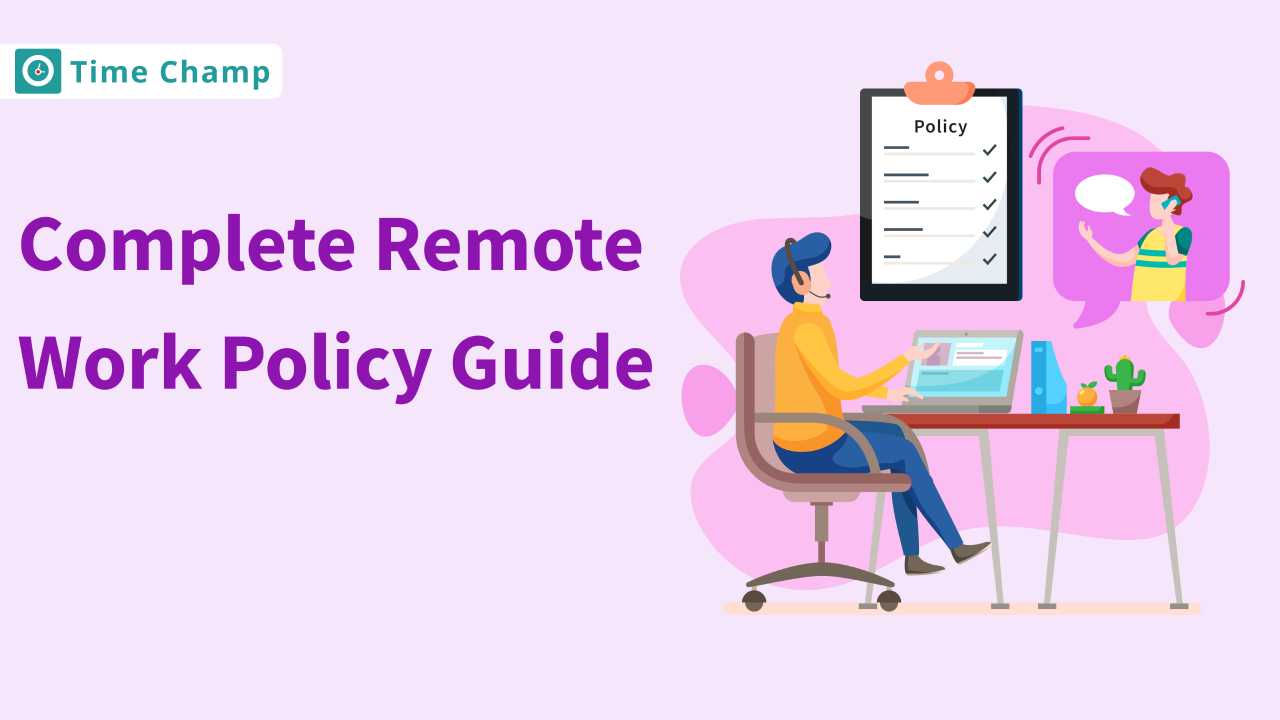Managing a remote team is not without its challenges and complexity. This guide will cover the techniques and tools that can help you navigate past these obstacles to remote workforce management.
Whether you find it hard to track remote employee activities or are having trouble maintaining the same productivity level that an in-office environment once offered, these problems have solutions thanks to innovative tools like those for remote productivity monitoring and workforce management software. In addition, through the effort of studying best practices, you will learn how to manage your remote team so that each member feels important and fully in their element.
As we explore these topics, it’s worth mentioning a tool that can significantly enhance your remote team management experience: Time Champ. It’s a comprehensive solution created for managers and teams who want to simplify their remote work and increase efficiency. To find out more, visit the Time Champ homepage.
So how do we overcome these difficulties? Let us begin this journey to unlock the power of managing remote teams and turn them into advantages for growth and prosperity.
Remote Teams’ Communication and Collaboration:
The key to good teamwork is effective communication, and when people work at a distance, it becomes even more important. Lacking face-to-face contact, it is easy to misunderstand each other and feel alienated. Managers must create space where open exchange is prized and specialized team tools are introduced to narrow the divide.
Best Practices for Virtual Communication
- Regular Check-ins: Establish routine one-on-ones and team meetings to set up an orderly flow of communication.
- Diverse Communication Channels: Use video calls for in-depth discussion and instant messaging for flash reports.
- Clear Expectations: Determine the modes of interaction for each type.
- Collaborative Tools for Remote Teams
- Project Management Software: These tools make it possible to track progress and centralize tasks.
- Shared Digital Workspaces: Google Workspace or Microsoft Teams provide access to documents and resources.
- Real-time Editing and Feedback: Promote the use of tools that allow teammates to cooperate on documents at the same time.
- Overcoming Time Zone Hurdles
- Flexible Scheduling: Set overlapping hours for real-time collaboration and allow asynchronous work.
- Time Zone Awareness: Utilize tools that provide awareness of member times to prevent scheduling conflicts.
Remote Team Culture-building and Maintenance:
Culture is believed to be something that springs up spontaneously from in-person contact. But it’s still important to develop a good team culture when apart. It means fostering a sense of belonging, building trust, and making the team’s goals coincide with those of the company.
Strategies for Cultivating Remote Culture
- Virtual Team Bonding: Hold online social activities and events that are not work-related.
- Recognition and Rewards: Recognize accomplishments to let team members know that their work is appreciated.
- Consistent Values: To keep everyone on the same page, strengthen this organization’s values in all remote interactions.
Ensuring Remote Employee Productivity:
It’s hard to maintain high levels of productivity when managing remote teams. Reduced productivity such as can also arise from distractions at home, differences in the level of self-motivation, and a lack of supervision. The right tools and methods can make all the difference.
Productivity Monitoring Tools
The key for managers is to combine trust with control. A viable solution is offered by monitoring tools such as Time Champ, which provide insight into employees ‘work without being intrusive. These are tools that track your time spent on different tasks and measure efficiency. and provide numerous functions to make sure the team is working efficiently.
Setting Clear Objectives
- SMART Goals: Establish SMART objectives for remote workers.
- Regular Performance Reviews: Use these appraisals to set targets for the future and evaluate progress, both of which provide incentives and direction.
Developing Self Management and Time Management
- Provide Training: train your team to manage their time well and discipline tasks.
- Encourage Breaks: Encourage regular breaks to avoid burnout and develop a healthy work-life balance.
Overseeing and Dealing with Remote Work Problems:
Some employees will not make an easy transition to remote work. Others are disconnected, have trouble with time management, or face technical problems. Then, finding these challenges early and dealing with them quickly will stop them from becoming productivity bottlenecks.
Identifying Remote Work Hurdles :
- Surveys and Feedback: Collect feedback regularly to find out what difficulties employees have.
- Observation: Employee monitoring tools to look out for patterns that illustrate a deeper problem, such as falling production or missed deadlines.
Remote Work Solutions for Common Problems
- Technical Support: Make sure employees are where they need to be, with good IT support available for quick resolution of technical problems.
- Remote Work Training: Conduct training sessions on the abilities required for successful remote work.
Using Remote Workforce Management Software
For remote managers, software like Time Champ can be a game-changer. These tools offer detailed insights into how remote workers spend their workday, and they retain project management, communication, and time-tracking functions to ensure that productivity and accountability remain.
Remote Staff and Legal, Security Concerns:
Remote work adds new layers of legal and security issues. To shield the business from risks, data protection, privacy laws, and regulations need to be taken into account.
Legal Considerations for Remote Employees
- Work Hour Regulations: Observe labour laws regarding work hours, overtime, and breaks for remote workers.
- Data Privacy Compliance: Inform employees about how they should comply with data privacy laws, such as GDPR for European staff.
Remote Team Security: Best Practices
- Secure Communication Channels: For all professional interchanges, use encrypted communication tools.
- Data Loss Prevention (DLP) Strategies: With the use of tools such as DLP, monitor and protect data transfers.
Employee Guidelines and Training
- Security Protocols: Teach remote workers about security practices, such as password management and identifying phishing attempts.
- Regular Security Updates: Give constant updates on threats and precautions to keep the staff alert.
Time Champ: a Comprehensive Remote Workforce Management Software
Time Champ is automated employee Time and productivity management software that is transforming how companies measure, monitor, and improve the performance and productivity of every department, team, and individual within an organization. By calculating productivity based on the work-related activities that employees engage in throughout their workday, Time Champ provides a robust framework for company growth initiatives.
Here’s how Time Champ can help managers overcome remote workforce management challenges with its comprehensive features:
- Automatic Employee Attendance: Efficiently track when employees start and finish their work, without the need for manual timesheets, which ensures accurate time reporting and can aid in payroll processing.
- Offline Tracking: Should your team members be without internet access, Time Champ’s offline tracking capability records activities until they reconnect, maintaining uninterrupted productivity monitoring.
- Employee Monitoring: Gain insights into employees’ computer usage during work hours, including the applications and websites utilized. This can help identify areas where guidance or additional support may be required.
- Activity Tracking: By capturing the precise activities of employees, Time Champ enables managers to analyze work patterns and behaviors, leading to better-informed decisions around workload distribution and performance management.
- Productivity Tracking: Time Champ’s ability to specifically delineate productive from non-productive time allows for a data-driven approach to understanding and boosting team productivity levels.
- Employee Location Tracking & Geo-Fencing: With remote work, it’s critical to ensure employees are working securely from approved locations. Time Champ’s location tracking and geo-fencing features can help manage this by setting location-based parameters for work.
- Live Video Recording and Screenshots: Although some may consider these features to be invasive, they can be critical tools in certain industries that demand high compliance or security standards.
- Office TV: This feature allows for the broadcast of productivity dashboards, creating transparency and motivation among team members who can see real-time performance metrics.
- Real-Time Reporting: Stay up to date with instant and real-time reports on your team’s performance. This can inform timely interventions and support continuous improvement efforts.
- Task Tracking and Project Management: Keep projects on track and ensure accountability by monitoring the progress of tasks against set timelines, assisting in identifying bottlenecks early on.
To explore more advanced Features of Time Champ at Time Champ.io
Time Champ positions itself as an all-encompassing platform that addresses many of the common challenges faced by managers of remote teams — from productivity tracking to ensuring compliance with work policies. The software thus acts as an essential tool for remote workforce management, enhancing efficiency, transparency, and accountability within distributed teams. For more detailed insights into how Time Champ can transform your remote team management book a demo today with Time Champ!
Conclusion:
Remote team management has its own set of problems, but they are not insurmountable. Managers lead successful remote teams by making effective use of the right communication methods, cultivating a solid team culture, maintaining productivity through appropriate tools and regulations, and being mindful of legal issues as well as security concerns. Technologies like Time Champ give managers a pulse on team performance and well-being. This journey is by no means over, but with these ideas in place, you can build a friendly and productive environment for all.
FAQs on Remote Team Management:
Encourage regular communication, use collaborative tools, and plan virtual team-building activities to create a sense of community.







